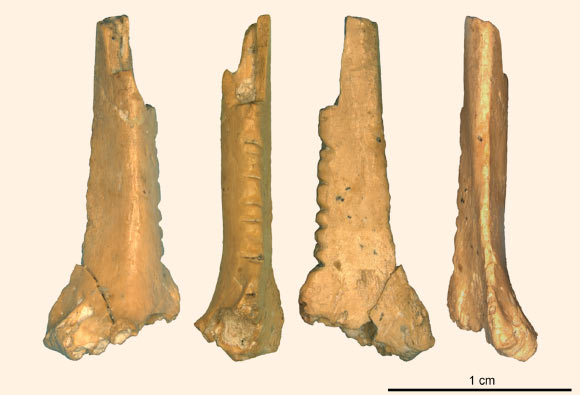Neanderthals’ cognitive abilities are a hotly debated topic, but a bird bone fragment found at a Middle Paleolithic site in Crimea, Ukraine, features two notches that may have been made by our extinct cousins intentionally to display a visually consistent pattern, according to a new study.

The raven bone fragment from the Zaskalnaya VI rock shelter. Scale bar – 1 cm. Image credit: A. Majkic et al, doi: 10.1371/journal.pone.0173435.
The bone fragment of a common raven (Corvus corax) was found at the Crimean multilayered site of Zaskalnaya VI, also known as Kolosovskaya or the site of Kolosov, near the village of Vishennoye, Belogorsk district.
The object comes from an archaeological level attributed to a Micoquian industry dated to at least 38,000 years ago.
The artifact — 18.14 mm long, 7.06 mm wide, and 2.49 mm thick — bears a set of evenly spaced notches that cannot be explained as resulting from butchery activities.
It was analyzed by Ana Majkic, an archaeologist at the University of Bordeaux and CNRS, and her colleagues from the University of Cambridge in UK, the University of the Witwatersrand in Johannesburg, South Africa, the NASU Institute of Archaeology and the I.I. Schmalhausen Institute of Zoology in Kiev, Ukraine.
The team conducted a mixed-methods study to assess whether the two extra notches on the Zaskalnaya raven bone were made by Neanderthals with the intention of making the final series of notches appear to be evenly spaced.
First, the researchers conducted a multi-phase experiment where recruited volunteers were asked to create evenly spaced notches in domestic turkey bones, which are similar in size to the raven bone.
Morphometric analyses reveal that the equal spacing of the experimental notches was comparable to the spacing of notches in the raven bone, even when adjusted for errors in human perception.
Archeological specimens featuring aligned notches from different sites were also analyzed and compared with the Zaskalnaya specimen.
The archaeologists concluded that the two extra notches on the Zaskalnaya raven bone may have been made by Neanderthals intentionally to create a visually consistent, and perhaps symbolic, pattern.
A series of recent discoveries of altered bird bones across Neanderthal sites has caused many researchers to argue that the objects were used for personal ornaments, as opposed to butchery tools or activities. But this study is the first that provides direct evidence to support a symbolic argument for intentional modifications on a bird bone.
This research was presented in a paper published in the journal PLoS ONE on March 29, 2017.
_____
A. Majkić et al. 2017. A decorated raven bone from the Zaskalnaya VI (Kolosovskaya) Neanderthal site, Crimea. PLoS ONE 12 (3): e0173435; doi: 10.1371/journal.pone.0173435







